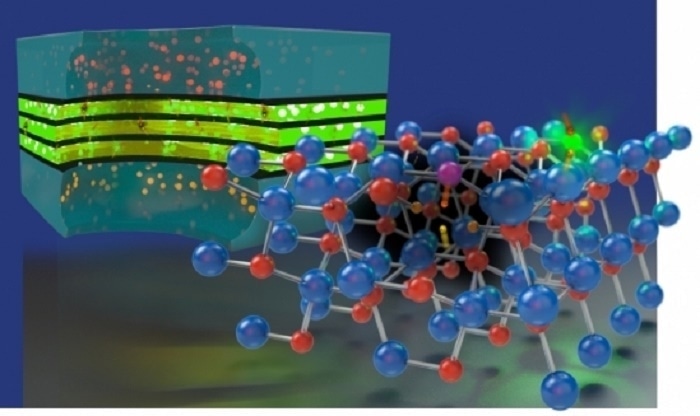Apr 7 2016
 A conceptual illustration of how defects in a crystal lattice might contribute to nonradiative recombination of electrons and holes in LEDs. Photo Credit: Peter Allen illustration
A conceptual illustration of how defects in a crystal lattice might contribute to nonradiative recombination of electrons and holes in LEDs. Photo Credit: Peter Allen illustration
UCSB researchers have used modern theoretical methods to detect particular defects that hinder the performance of a light-emitting diode (LED). The characterization of such defects present in the LED’s atomic structure could result in the development of longer lasting and more efficient LED lighting.
Techniques are available to assess whether such defects are present in the LED materials and they can be used to improve the quality of the material.
Chris Van de Walle, Materials Professor, UCSB
Currently, not all LEDs are similar due to the abundance of high-efficiency solid-state lighting. As the technology is employed in a complex range of applications, efficiency and reliability are of great significance. These applications include safety illumination, water purification, and search and rescue. The technology also has decorative, industrial, and residential applications. Performance mainly depends on the semiconductor material’s quality at the atomic level.
In an LED, electrons are injected from one side, holes from the other.
Chris Van de Walle, Materials Professor, UCSB
As they pass along the semiconductor’s crystal lattice - in this case a gallium-nitride-based material - the meeting of holes and electrons is responsible for the light emitted by the diode. This meeting moves to a lower energy state, and a photon is also released during this process.
However, there are times when the charge carriers meet but do not emit light, resulting in the Shockley-Read-Hall (SRH) recombination. The researchers highlight that the charge carriers are seized at defects existing in the lattice where they meet without giving out light.
The identified defects have complexes of gallium vacancies with hydrogen and oxygen.
“These defects had been previously observed in nitride semiconductors, but until now, their detrimental effects were not understood,” explained lead author Cyrus Dreyer, who performed many of the calculations on the paper.
It was the combination of the intuition that we have developed over many years of studying point defects with these new theoretical capabilities that enabled this breakthrough.
Chris Van de Walle, Materials Professor, UCSB
Van de Walle credits co-author Audrius Alkauskas with the development of a theoretical formalism that is vital to determine the rate at which defects capture holes and electrons.
Van de Walle stated that the technique makes way for future studies focusing on detecting other mechanisms and defects by which SRH recombination take place.
These gallium vacancy complexes are surely not the only defects that are detrimental. Now that we have the methodology in place, we are actively investigating other potential defects to assess their impact on nonradiative recombination.
Chris Van de Walle, Materials Professor, UCSB
The paper is published in the April 4 issue of Applied Physics Letters, along with an accompanying figure on the journal’s cover.
The research was financially supported by Marie Sklodowska-Curie Action of the European Union, and the U.S. Department of Energy Office of Science.